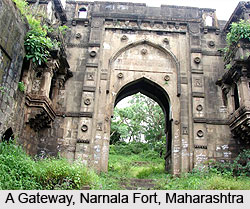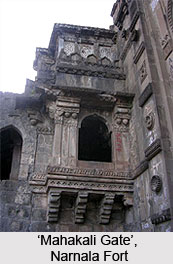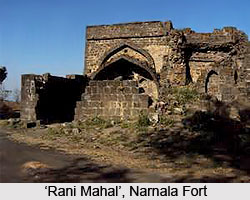 Narnala Fort is also referred to as `Shanur Fort` and is a hillside fortress situated in the western Indian state of Maharashtra and has been named after Narnal Singh, a Rajput king, constructed during 10th century AD by the Gonds. The Mughals had remodelled Narnala Fort in the 15th century and it comprises three different forts like Teliagarh Fort in the west, Narnala Fort in central part and Zafarabad Fort on the east. It is believed that the lake present in the middle portion of the fort premises contains healing characteristics and also the legendary philosopher`s stone. However no stone has been discovered from here during the famines which occurred between 1899 and 1900. The Islamic saint Hazrat Burhanuddin is said to have resided in the fort, along with some tigers and the fort probably has been occupied since the era of Khilji Dynasty. Numerable Arabic inscriptions have been embedded onto the walls of the fort by Atalu Beg or Adli Beg. The great Kadak Bijli cannon is existent here and the great grandson of Aurangzeb was born in the Narnala Fort.
Narnala Fort is also referred to as `Shanur Fort` and is a hillside fortress situated in the western Indian state of Maharashtra and has been named after Narnal Singh, a Rajput king, constructed during 10th century AD by the Gonds. The Mughals had remodelled Narnala Fort in the 15th century and it comprises three different forts like Teliagarh Fort in the west, Narnala Fort in central part and Zafarabad Fort on the east. It is believed that the lake present in the middle portion of the fort premises contains healing characteristics and also the legendary philosopher`s stone. However no stone has been discovered from here during the famines which occurred between 1899 and 1900. The Islamic saint Hazrat Burhanuddin is said to have resided in the fort, along with some tigers and the fort probably has been occupied since the era of Khilji Dynasty. Numerable Arabic inscriptions have been embedded onto the walls of the fort by Atalu Beg or Adli Beg. The great Kadak Bijli cannon is existent here and the great grandson of Aurangzeb was born in the Narnala Fort.
Narnala Fort is situated in the Akot Taluka close to Akola District or Berar which constitutes Amravati Division and its closest city is Akot which is located at a distance of 18 kms away from the fort. It is based at an altitude measuring about 912 metres above mean sea level, at the southernmost point of the Satpura Ranges. Presently, Narnala Fort is present in the grounds of Melghat Tiger Reserve.
History of Narnala Fort
 The Shanoor or Narnala Fort was constructed by Sultan Mahmoud Gazhnavi as he was a disciple of Bagh-Sawar Wali Hazrat Burhanuddin. When Akbar conquered Berar, he remodified this fortress employing Mughal architectural elements and added a mosque. Narnala Fort was repaired during 1425 by Ahmad Shah Bahamani around the same time when he had created the Gavilgad Fort, to safeguard his kingdom against invaders from the northern parts of his land. In 1490 the fort was given to Subehdar of Berar, Fatehulla Imad-ul-mulk who worked for Bahamani Dynasty and he also received possession of the Gavilgad fort. When Burhan Imad Shah was taken prisoner here by Tufalkhan. Tufalkhan was defeated in the battle between Murtaza Nizam Shah and the former during 1572 and he sought shelter from Muhammad Shah of Khandesh. However Tufalkhan had to return to Narnala Fort as Muhammad Shah was persuaded by Murtaza Nizam Shah to refuse him shelter. During that point of time, Murtaza`s troops filled every corner of this fort who imprisoned Tufalkhan and Burhan Imad Shah, keeping them locked in Lohagad Fort where they were said to have been poisoned.
The Shanoor or Narnala Fort was constructed by Sultan Mahmoud Gazhnavi as he was a disciple of Bagh-Sawar Wali Hazrat Burhanuddin. When Akbar conquered Berar, he remodified this fortress employing Mughal architectural elements and added a mosque. Narnala Fort was repaired during 1425 by Ahmad Shah Bahamani around the same time when he had created the Gavilgad Fort, to safeguard his kingdom against invaders from the northern parts of his land. In 1490 the fort was given to Subehdar of Berar, Fatehulla Imad-ul-mulk who worked for Bahamani Dynasty and he also received possession of the Gavilgad fort. When Burhan Imad Shah was taken prisoner here by Tufalkhan. Tufalkhan was defeated in the battle between Murtaza Nizam Shah and the former during 1572 and he sought shelter from Muhammad Shah of Khandesh. However Tufalkhan had to return to Narnala Fort as Muhammad Shah was persuaded by Murtaza Nizam Shah to refuse him shelter. During that point of time, Murtaza`s troops filled every corner of this fort who imprisoned Tufalkhan and Burhan Imad Shah, keeping them locked in Lohagad Fort where they were said to have been poisoned.
However, the actual time of establishment of the Narnala Fort is clouded in mystery and regional legendary tales state that it was erected by a certain descendant of Pandavas known as Naryendrapun, dating around the period prior to 1400 CE. Historians claim that Narnala Fort was restored by Badshaha Shahbudeen Ahmad Shah I Wali when he had constructed the Gavilgad Fort and then he had camped at Elichpur, especially from 1425 till 1428. Khan-i-Jahan, the Governor of Berar returned to Narnala Fort during Nashir Khan`s invasion of Berar during 1437 as he decided not to desert his master Ala-ud-din Ahmad Shah II. Narnala Fort and Gavilgad Fort slipped into the control of the founder of the Imad Shahi Dynasty at Achalpur or Elichpur named of Fateh-ullah Imad-ul-Mulk. During the regime of Akbar, Narnala Fort was controlled by him and it eventually was conquered in 1701 CE by Parsoji Bhonsle. The Marathas gained the fort and continued to own it till the British seized it during 1803 CE.
 Architecture of Narnala Fort
Architecture of Narnala Fort
Narnala Fort occupies an area measuring about 326 acres and is equipped with 21 small gateways, six gigantic gateways and 360 watchtowers. `Shahanur Darvaza`, `Akot Darvaza`, `Sirpur Darvaza` and `Delhi Darvaza` are the names of the large gates. The `Mahakali Gate` or the Shanur Gate is the innermost amongst all the three gateways. White sandstone was employed to manufacture this gate which is beautifully embellished. Motifs of lotus flowers, Arabic inscriptions and stone-latticed works decorate the interiors of the Narnala Fort. Delhi Sultanate style of architecture has been followed in the construction of the Narnala Fort and its gate was created by Fataullah Imad-ul-Mulk under the regime of Shahab-ud-din Mahmud Shah (Bahmani) in the year 1486. One would discover a Quranic inscription on the fort walls, besides it exhibition of `Ashtakamal` or eight lotus petals, the imperial sign of Narnal Singh. The fort is home to 1 water tanks, an aqueduct and drains to store rainwater.




